Scattered across the globe, from remote landscapes to city parks, lie massive boulders known as glacial erratics. These awe-inspiring geological wonders, transported and deposited by ancient glaciers during past ice ages, stand as silent testaments to the immense power of nature.
Glacial erratics are rocks that differ in size, composition, and origin from the native bedrock upon which they rest, having been carried great distances by the slow-moving ice. In this article, we will embark on a journey to discover the top 12 largest glacial erratics in the world, exploring their fascinating histories, unique characteristics, and the scientific insights they provide into Earth’s glacial past.
Big Rock (Okotoks Erratic) – Alberta, Canada
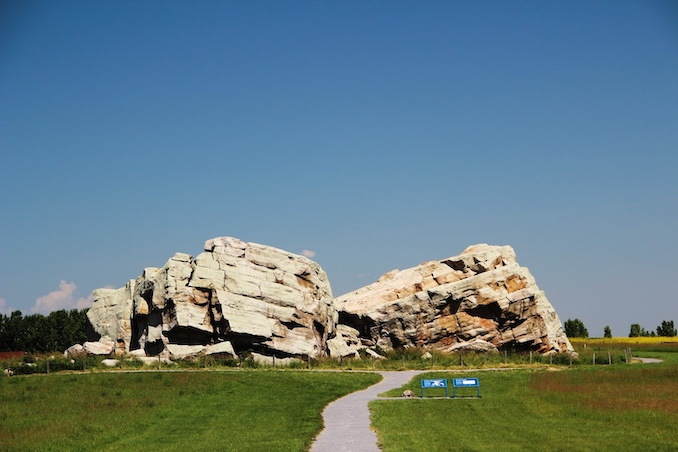
Nestled in the foothills of the Canadian Rockies, just south of Calgary, Alberta, lies the enormous Big Rock, also known as the Okotoks Erratic. This colossal quartzite boulder, measuring approximately 9 meters high, 41 meters long, and 18 meters wide, weighs an estimated 16,500 tonnes. The Big Rock is believed to have originated in the Athabasca Valley of Jasper National Park, some 400 kilometers to the northwest, and was transported to its current location by the Laurentide Ice Sheet during the Pleistocene epoch, between 12,000 and 17,000 years ago.
The Big Rock holds great cultural significance for the Blackfoot First Nations people, who have several legends surrounding its origin and meaning. One such legend tells of a giant who hurled the rock at a smaller giant, leaving the boulder where it now rests. The site is considered sacred and is used for ceremonies and offerings to this day.
Ehalkivi (Sunset Glow Boulder) – Viru-Nigula Parish, Estonia

The Ehalkivi, or Sunset Glow Boulder, is the largest glacial erratic in Estonia and one of the largest in Europe. Situated in the Letipea area of Viru-Nigula Parish, this impressive granite boulder measures approximately 7 meters high, 16.5 meters long, and 14.3 meters wide, with an estimated weight of 780 tonnes. The Ehalkivi was transported to its current location by the massive continental glacier that covered Estonia during the last ice age, roughly 12,000 years ago.
According to local folklore, the Ehalkivi is believed to possess healing powers, particularly during the summer solstice when the sun sets behind the boulder, casting a warm, golden glow across its surface. Visitors often leave offerings and tie ribbons around the nearby trees as a sign of respect and to make wishes.
Morrow Rock – Whitman County, Washington, USA

Morrow Rock, also known as the Morrow Erratic, is the largest glacial erratic in Washington State and one of the largest in the United States. Located on private farmland in Whitman County, this massive basalt boulder measures approximately 9 meters high, 27 meters long, and 24 meters wide, with an estimated weight of 2,000 tonnes. Morrow Rock was transported to its present location by the Cordilleran Ice Sheet during the last glacial period, which ended around 11,700 years ago.
The boulder’s surface bears the scars of its glacial journey, with deep striations and grooves etched into the basalt by the grinding action of the ice and embedded debris. Morrow Rock serves as a valuable scientific resource, providing geologists with insights into the direction and extent of glacial movement in the region during the Pleistocene epoch.
Le Bloc Erratique – Monthey, Switzerland
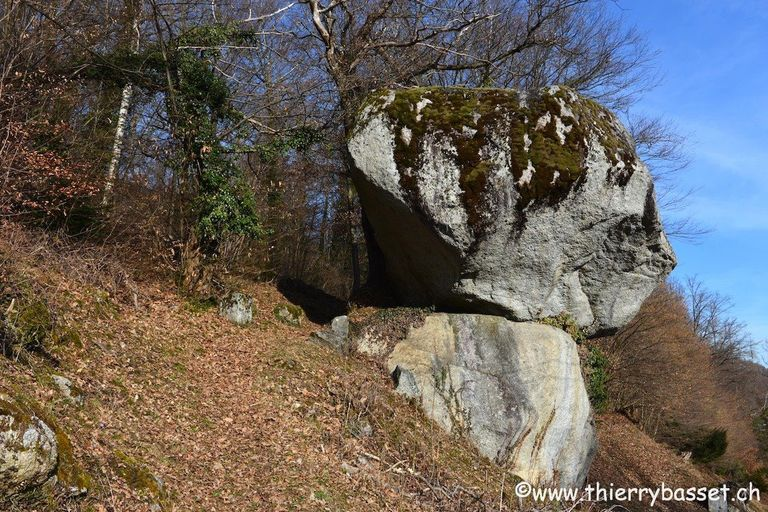
Le Bloc Erratique, or The Erratic Block, is a massive granite boulder located in the town of Monthey, in the canton of Valais, Switzerland. Measuring approximately 10 meters high, 16 meters long, and 9 meters wide, with an estimated weight of 1,600 tonnes, Le Bloc Erratique is one of the largest glacial erratics in Switzerland. The boulder was transported to its current location by the Rhône Glacier during the last ice age, around 18,000 years ago, from the Mont Blanc massif, some 100 kilometers to the south.
The boulder’s unique shape and imposing presence have made it a local landmark and a popular spot for rock climbing. Le Bloc Erratique also serves as a reminder of the profound impact that glacial activity has had on the Swiss landscape, shaping the valleys, mountains, and lakes that define the country’s iconic alpine scenery.
Tripod Rock – Morris County, New Jersey, USA
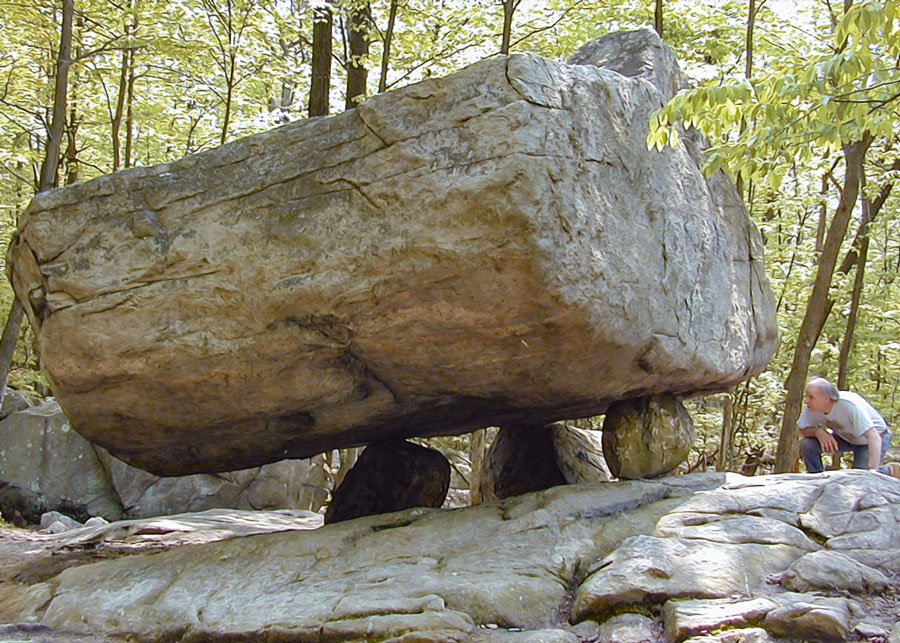
Tripod Rock is a peculiar glacial erratic located in Pyramid Mountain Natural Historic Area, Morris County, New Jersey. This large granite boulder, estimated to weigh around 180 tonnes, is precariously balanced on three smaller boulders, creating a distinctive tripod-like appearance. Tripod Rock was deposited in its current position by the Wisconsin Glacier during the last ice age, approximately 18,000 years ago.
The boulder’s unique balancing act has made it a popular hiking destination and a subject of fascination for visitors. Geologists believe that Tripod Rock’s precarious position is the result of the gradual erosion of the surrounding soil and smaller rocks over thousands of years, leaving the boulder suspended on its three points of contact.
Indian Rock – Montebello, New York, USA

Indian Rock, located in Montebello, Rockland County, New York, is one of the largest glacial erratics in the United States. This massive granite boulder, measuring approximately 18 meters long, 12 meters wide, and 9 meters high, weighs an estimated 17,000 tonnes. Indian Rock was transported to its current location by the Laurentide Ice Sheet during the Wisconsin Glaciation, which reached its maximum extent around 18,000 years ago.
The boulder’s name is derived from the local Native American Lenape tribe, who used the rock as a meeting place and a lookout point. Indian Rock also bears evidence of its glacial origins, with deep striations and grooves carved into its surface by the grinding action of the ice and embedded debris.
Kukkarokivi – Ruokolahti, Finland
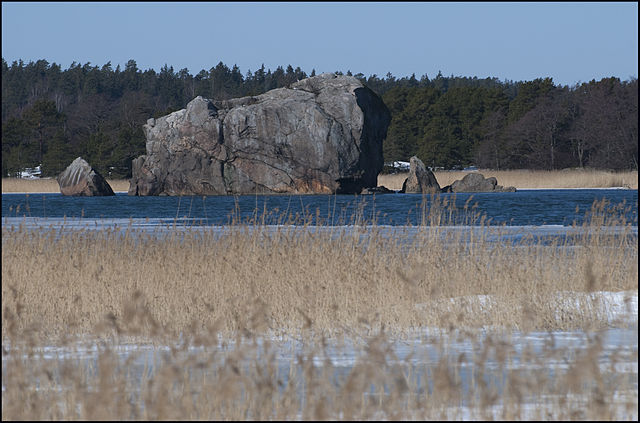
Kukkarokivi is a massive glacial erratic located in the municipality of Ruokolahti, in southeastern Finland. This impressive rapakivi granite boulder measures approximately 7 meters high, 14 meters long, and 12 meters wide, with an estimated weight of 500 tonnes. Kukkarokivi was transported to its current location by the Scandinavian Ice Sheet during the Weichselian glaciation, which ended around 11,700 years ago.
The boulder’s name, which translates to “Rooster Rock,” is derived from its distinctive shape, which resembles a rooster’s head when viewed from certain angles. Kukkarokivi is a popular local landmark and a testament to the powerful glacial forces that shaped the Finnish landscape during the Pleistocene epoch.
Hérisson Erratic – Vouvray, France

The Hérisson Erratic, located in the commune of Vouvray, in the Loire Valley of France, is a large puddingstone boulder that was transported to its current location by the Scandinavian Ice Sheet during the Saalian glaciation, approximately 200,000 years ago. This unique glacial erratic measures approximately 5 meters high, 10 meters long, and 8 meters wide, and weighs an estimated 300 tonnes.
Puddingstone is a type of sedimentary rock composed of rounded pebbles and cobbles cemented together by a finer-grained matrix. The Hérisson Erratic’s composition and origin differ significantly from the surrounding limestone bedrock, providing valuable insights into the extent and direction of glacial movement in the region during the middle Pleistocene.
Big Rock (Purgatory Chasm) – Sutton, Massachusetts, USA
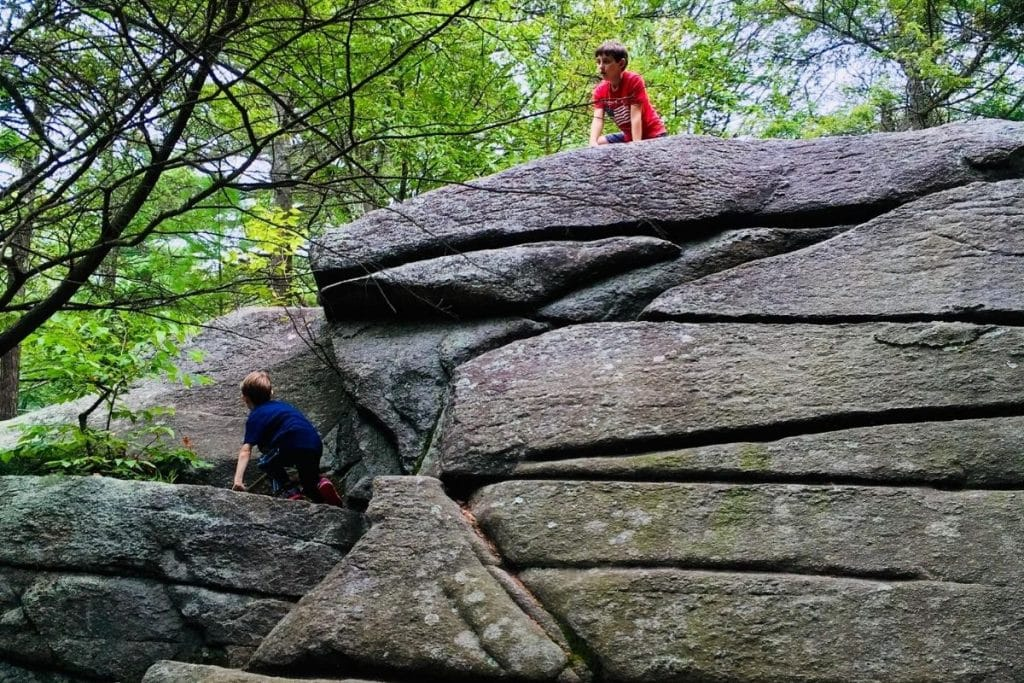
The Big Rock at Purgatory Chasm State Reservation in Sutton, Massachusetts, is a large glacial erratic that sits atop a narrow, 21-meter-deep chasm formed by glacial meltwater erosion during the last ice age. This impressive granite boulder, measuring approximately 12 meters long, 6 meters wide, and 4 meters high, weighs an estimated 300 tonnes.
The Big Rock and the surrounding Purgatory Chasm offer visitors a unique opportunity to observe the dramatic effects of glacial erosion on the landscape. The deep, narrow chasm and the precariously perched boulder serve as reminders of the immense power of glacial meltwater and the role it played in shaping the New England landscape during the Pleistocene epoch.
Norber Erratics – Yorkshire Dales, England
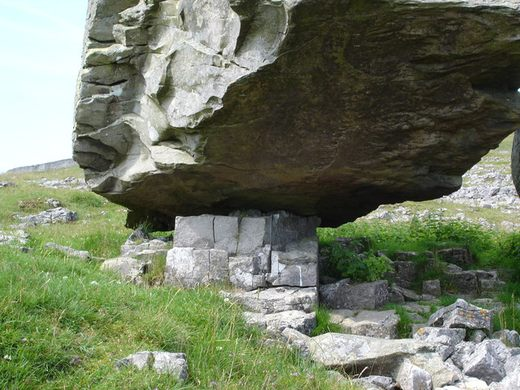
The Norber Erratics are a group of distinctive glacial erratics located in the Yorkshire Dales National Park, near the village of Austwick, England. These large boulders, composed of Silurian gritstone, were transported to their current location by the Devensian Ice Sheet during the last glacial period, which ended around 11,700 years ago.
What makes the Norber Erratics particularly interesting is their relationship to the underlying limestone bedrock. The boulders are perched on pedestals of limestone, which have been eroded away at a slower rate than the surrounding rock, leaving the erratics standing proud of the surface. This phenomenon, known as differential erosion, provides a visual representation of the passage of time since the boulders were deposited by the retreating glacier.
Rocking Stone – Fall River, Massachusetts, USA

The Rocking Stone is a large glacial erratic located in Fall River, Massachusetts, USA. This granite boulder, measuring approximately 6 meters long, 4 meters wide, and 3 meters high, weighs an estimated 140 tonnes. The Rocking Stone is precariously balanced on a smaller boulder, allowing it to be slightly moved or “rocked” by human force, hence its name.
The Rocking Stone was transported to its current location by the Laurentide Ice Sheet during the Wisconsin Glaciation, which reached its maximum extent around 18,000 years ago. The boulder’s delicate balance and the fact that it can be moved by human power have made it a popular local attraction and a subject of fascination for visitors.
Brimham Rocks – North Yorkshire, England
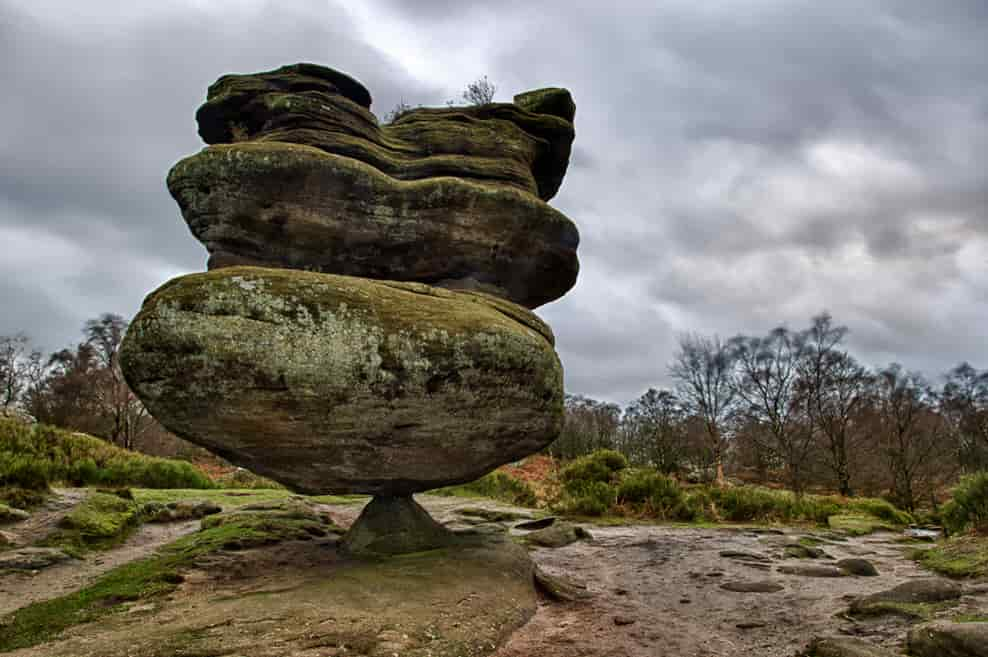
Brimham Rocks is a collection of large, unusually shaped sandstone erratics located in the Nidderdale Area of Outstanding Natural Beauty, near Harrogate, North Yorkshire, England. These distinctive boulders, some of which stand over 30 meters tall, were sculpted by the erosive forces of wind, rain, and ice over millions of years, creating a surreal, otherworldly landscape.
While not technically glacial erratics, as they were not transported far from their original location, Brimham Rocks are a testament to the power of erosion in shaping the landscape. The site is a popular destination for hikers, climbers, and those seeking to explore the unique geological formations and enjoy the stunning views of the surrounding countryside.
Conclusion
Glacial erratics, from the massive Big Rock in Alberta, Canada, to the precariously balanced Rocking Stone in Fall River, Massachusetts, serve as powerful reminders of the immense forces that have shaped our planet over millions of years. These awe-inspiring boulders, transported and deposited by ancient glaciers, provide valuable insights into Earth’s glacial history and the dramatic climate changes that have occurred during the Pleistocene epoch.
Beyond their scientific significance, glacial erratics also hold cultural and spiritual importance for many communities around the world. They serve as landmarks, meeting places, and sacred sites, weaving together the natural and human histories of the landscapes they inhabit.
As we continue to study and appreciate these geological wonders, we gain a deeper understanding of the complex and dynamic processes that have shaped our world. The top 12 largest glacial erratics showcased in this article represent just a fraction of the countless erratic boulders scattered across the globe, each with its own unique story to tell. By exploring these remarkable features, we not only marvel at the power of nature but also gain perspective on our own place within the vast timescales of Earth’s history.

